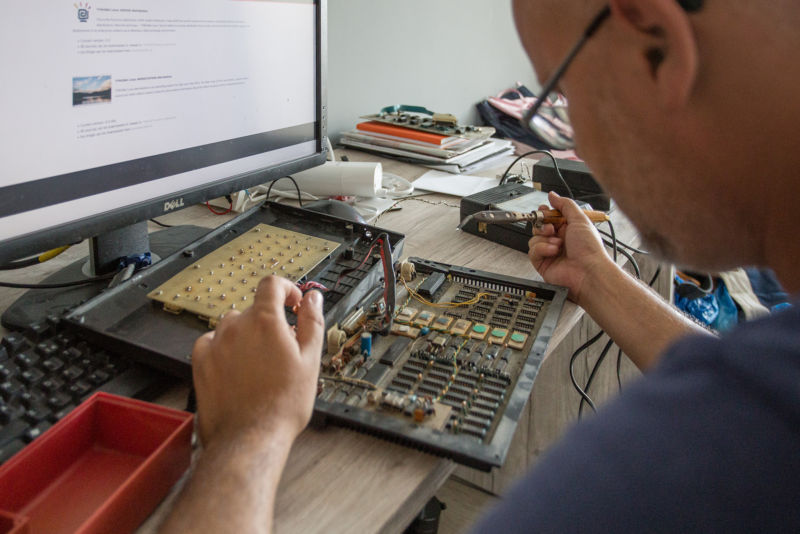
BUCHAREST, Romania—Mihai Moldovanu grabs the cardboard box with the enthusiasm of a man from the future who’s opening a time capsule.
“Maybe it could still work,” he tells me.
He dusts it off with his hands. Inside the box rests the computer he built for himself in high school. He hasn’t switched it on in 10, maybe 20 years. This summer, when moving from one apartment to another, he stumbled upon the box. “I need to find a charger and an old TV set. It’s going to be tricky to revive it.”
An athletic geek now in his mid-40s, Moldovanu has always been crafting DIY projects. In the local open-source community, he is better known as one of the creators of the first Romanian Linux distribution, TFM, that’s still used by local companies. His 9-to-5 job is that of a System Administrator for a fin-tech company in Bucharest.
What Moldovanu’s holding isn’t some hobbyist kit potentially familiar to tech tinkerers back in the states. In the mid-1980s, Romania was a poverty-stricken, Communist country. So like a handful of his fellow students with a similar undeniable passion for computing, Moldovanu soon became one of only a few dozen underground computer builders in the country. They illegally manufactured computers using parts smuggled from factories and heaps of manually soldered wires. But armed with very few resources and plenty of creativity, people like Moldovanu soon fueled an underground hardware industry that would birth some of the country’s best future tech professionals.
-
Mihai Moldovanu revisiting the Cobra he learned to build underground in 1980s Romania.Adi Dabu
-
"It was a highly illegal operation. And we knew this very well,” Moldovanu tells Ars. “But to us, it didn’t matter. We were super excited to turn a pile of parts into a cool project.”Adi Dabu
Illegally connecting Romania
To a young Moldovanu, computers were magic. The country he grew up in barely had access to landline telephones and black-and-white TV sets, and he rarely came across Western goods. Romania had its borders closed tightly. For the average citizen, there were no opportunities to travel or to receive accurate news regarding what was the state of technology in the West.
Instead, during the last years under dictator Nicolae Ceaușescu in the late 1980s, people would wake up at 5am to stand in line in front of stores for their modest food rations. Electricity was often cut to save money; heating was, too. This was the environment when the underground tech industry started: around 1985, four years before the bloody Romanian revolution that knocked down Communism.
Back then, Romania’s hardware industry mainly cloned the British Sinclair ZX Spectrum, a machine released in the UK in 1982. This device was copied all across Central and Eastern Europe. The ZX Spectrum was an 8-bit personal computer built around a Zilog Z80 A CPU running a BASIC interpreter, an easy-to-use programming language widespread on microcomputers at that time. It used a TV set as a display and audio cassettes for storage.
Among the clones manufactured by the Communists was the Cobra or CoBra. The name stands for COmputere BRAsov, with Brasov being the town in central Romania where these machines were assembled to be used by enterprises. Of course, ordinary people couldn’t buy them—which is what first led several students at the Politehnica University of Bucharest deciding to build them themselves.
“It was a highly illegal operation. And we knew this very well,” Moldovanu tells me. “But to us, it didn’t matter. We were super excited to turn a pile of parts into a cool project.”
If militia officers caught Moldovanu and colleagues while they were selling computes, however, it'd matter. The authorities could seize the students’ electronics, make them pay fines, and could expel them from the university for starters.
Given how dire daily life was for Romanians at the time, something as little as a pack of Western cigarettes would buy anything that could be smuggled from a factory. So the Politehnica students leveraged their resources to obtain some Cobra motherboards and independently started to build computers on top of those. Soon, an entire supply chain was formed. Electronics dealers came to the campus with computer parts, LEDs, and resistors, which they sold in bulk. The students became fond of Cobras, as they featured not only BASIC but also CP/M, an operating system created for Intel 8080/85-based microcomputers.
The builders used whatever was available on the black market; no two computers ever seemed to come out alike. Lucky owners fit their Cobras into cases from another Romanian ZX Spectrum clone, the HC. Others used manufactured metal or wooden boxes.
“I didn’t care about the case,” Moldovanu says. “Most of the time, my computer worked with its parts spread on my desk. If I broke it, I would fix it myself.”
In this closed Communist country with choice regulated by the state, Cobras gave their owners some feeling of independence and rebellion. “The fact that you could play the game you wanted, when you wanted, gave you the illusion of choosing for yourself,” Moldovanu says. Three decades later, he still knows by heart Highway Encounter, Chuckie Egg, and Nether Earth, which featured Isometric 3D Graphics, meaning that it was 2D, but looked 3D-ish. Moldovanu was amazed at the graphics, and so he began studying the algorithm to learn how it was possible to achieve them.
reader comments
121